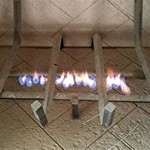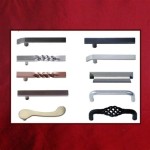Fireplace Mantel and Hearth: Design, Functionality, and Installation
The fireplace, a long-standing focal point in residential architecture, provides warmth, ambiance, and a sense of gathering. Integral to the overall impact of a fireplace are the mantel and hearth, functional and aesthetic components that contribute significantly to the room's design. Understanding the purpose, materials, styles, and installation considerations of these elements is crucial for homeowners seeking to enhance their living spaces.
The mantel and hearth serve distinct but complementary roles. The mantel, traditionally a shelf above the fireplace opening, provides a platform for displaying decorative items, photographs, and seasonal accents. It visually anchors the fireplace within the room's framework. The hearth, the non-combustible area extending in front of and surrounding the firebox opening, serves a practical function by protecting the flooring and adjacent surfaces from sparks, embers, and radiant heat. Together, these features create a cohesive and visually appealing fireplace surround.
The Functionality of a Fireplace Mantel and Hearth
The functional importance of the hearth cannot be overstated. Its primary purpose is safety. It acts as a barrier, preventing errant embers from igniting carpets, rugs, or wooden flooring. Building codes often specify minimum dimensions for hearth extensions based on the type of fireplace and fuel being used. Insufficient hearth protection can lead to significant fire hazards. Therefore, understanding and adhering to local building codes is essential during fireplace design and installation.
Mantels, while primarily decorative, also offer a degree of functional support. They can conceal unsightly seams between the fireplace surround material and the wall, providing a clean, finished look. Furthermore, mantels can act as a heat shield, deflecting rising heat away from flammable materials such as drywall or wallpaper above the fireplace. The placement and material of the mantel are vital in achieving this heat-shielding effect. Consultations with professionals are recommended to ensure proper placement and material selection.
Beyond safety and protection, both the mantel and hearth contribute to the fireplace's efficiency. The hearth, particularly if constructed from a material with high thermal mass, can absorb and radiate heat into the room even after the fire has died down, improving overall heating performance. Similarly, a well-designed mantel can help to direct airflow within the room, optimizing heat distribution.
Materials for Fireplace Mantels and Hearths
The selection of materials for the mantel and hearth is a crucial decision that impacts both the aesthetics and functionality of the fireplace. A wide range of materials is available, each with its own unique properties and characteristics. Wood is a popular choice for mantels, offering warmth, versatility, and a traditional aesthetic. Common wood species include oak, maple, pine, and cherry. The selected wood should be properly seasoned and treated to prevent warping, cracking, or combustion. Solid wood mantels offer a natural and durable option, while engineered wood products provide a more cost-effective alternative.
Stone is another frequently used material, particularly for hearths. Granite, marble, slate, and limestone are all common choices, offering durability, heat resistance, and a luxurious aesthetic. Natural stone hearths feature unique variations in color and pattern, adding character to the fireplace. Cultured stone, a manufactured product that mimics the look of natural stone, offers a more uniform and affordable alternative. When selecting stone, consider its porosity, stain resistance, and thermal conductivity.
Other materials used in fireplace design include brick, concrete, and metal. Brick is often used for both mantels and hearths, providing a rustic and traditional look. Concrete hearths offer a modern and minimalist aesthetic, while metal mantels can create a sleek and contemporary design. The choice of material should complement the overall style of the room and the existing fireplace surround.
Styles and Design Considerations for Fireplace Mantels and Hearths
The style and design of the mantel and hearth should harmonize with the overall architectural style of the home. Traditional homes often feature ornate mantels with intricate carvings, detailed moldings, and classic architectural details. These mantels are typically paired with hearths made from natural stone, such as marble or granite, adding to the sense of elegance and refinement.
Contemporary homes often feature simpler, more minimalist mantels with clean lines and geometric shapes. Materials such as concrete, metal, and glass are commonly used in contemporary designs, creating a sleek and modern aesthetic. Hearths in contemporary homes may be flush with the floor or raised slightly, depending on the desired effect.
Rustic homes often feature mantels made from reclaimed wood or rough-hewn timbers, adding a sense of warmth and character to the fireplace. Stone hearths, made from natural materials such as river rock or flagstone, complement the rustic aesthetic. The design emphasizes natural textures and materials, creating a cozy and inviting atmosphere.
Beyond architectural style, design considerations should also include the size and scale of the room. A large, ornate mantel may overwhelm a small room, while a small, simple mantel may get lost in a large room. The proportions of the mantel and hearth should be carefully considered to ensure a balanced and harmonious design.
The placement of the mantel and hearth within the room is another important consideration. The fireplace should be positioned as a focal point, drawing the eye and creating a sense of visual balance. The mantel should be at a comfortable viewing height, and the hearth should be large enough to provide adequate protection from sparks and embers. The surrounding furniture and décor should be arranged to complement the fireplace, creating a cohesive and inviting space.
Installation Considerations for Fireplace Mantels and Hearths
Proper installation of the mantel and hearth is crucial for both safety and aesthetics. Incorrect installation can lead to structural problems, fire hazards, and an unsightly appearance. It is generally recommended to hire a qualified professional for fireplace mantel and hearth installations, particularly if the project involves structural modifications or gas line connections.
Before beginning the installation, it is essential to ensure that the existing fireplace structure is sound and in good condition. The chimney should be inspected for cracks or damage, and any necessary repairs should be made before proceeding. The firebox should be clean and free of debris, and the gas line (if applicable) should be inspected for leaks.
The installation process for a mantel typically involves attaching the mantel to the wall using screws, brackets, or adhesive. The specific method will depend on the weight and size of the mantel, as well as the type of wall construction. It is important to use appropriate fasteners and to ensure that the mantel is securely attached to the wall. The manufacturer's instructions should be carefully followed to ensure a proper installation.
Hearth installation typically involves preparing the subfloor, laying a mortar bed, and setting the hearth material in place. The mortar bed should be level and smooth to ensure that the hearth is evenly supported. Grout is then applied to fill the joints between the hearth tiles or stones. Proper curing time is essential for the mortar and grout to fully harden and provide a durable, watertight seal.
During the installation process, it is important to adhere to all local building codes and safety regulations. This includes ensuring that the hearth meets the minimum size requirements and that the mantel is properly spaced from the firebox opening. Failure to comply with building codes can result in fines, delays, and potential safety hazards.
After the installation is complete, the fireplace should be inspected by a qualified professional to ensure that it is safe and properly functioning. The chimney should be checked for proper draft, and the gas line (if applicable) should be tested for leaks. Once the inspection is complete, the fireplace can be used and enjoyed safely.
Maintaining the fireplace mantel and hearth is also essential for longevity and safety. Regular cleaning is needed to remove soot, dust, and other debris. Stone surfaces should be sealed periodically to protect against staining and water damage. Wood mantels should be inspected for cracks or warping and repaired as needed. Following these maintenance guidelines helps ensure the fireplace remains a safe and attractive feature of the home for years to come.

Stone Mantels Hearth Home

Fireplace Mantle Redo In Time For Diary Of A Quilter Quilt Blog Home Living Room With Hearth Decor

Conrad Cast Stone Fireplace Mantel Old World Stoneworks
:max_bytes(150000):strip_icc()/cozy-fall-mantel-decorating-5dfcd9f83cbc45c9ab67357fe2b52b40.jpeg?strip=all)
28 Fall Mantel Decorating Ideas To Make Your Hearth More Homey

Fireplace Mantel Surround With Granite Hearth Monk S In

The Importance Of A Fireplace Surround Vertical Chimney Care

Mantel And Hearth Considerations For Your Fireplace We Love Fire

My Spring Fireplace Mantel And Hearth Decor

Mantel And Hearth Considerations For Your Fireplace We Love Fire

Size Of Fireplace Hearth In Relation To Mantel








